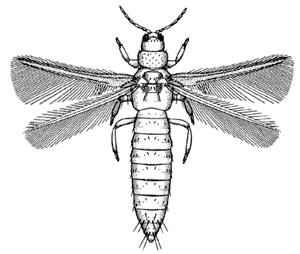|
Thysanoptera:
thrips
Characteristics
Thrips are small winged insects ranging in size from 0.5-15 millimetres
in length. They are closely related to bugs
(Hemiptera) with similar sucking mouthparts but can be
distinguished by the following features:
|

Thrips australis THRIPIDAE
(Eucalyptus thrips)
|
|
- Slender,
cylindrical, elongate body
- Sucking and
rasping mouthparts
- 2 pairs of
slender membranous
wings that are fringed with long hairs. Some species are wingless
- Legs that
end in a bladder-like organs not a typical tarsal
claw
Thrips australis
belongs to the THRIPIDAE family and is common among Eucalyptus
flowers where it is thought to feed on nectar.
Life Cycle
Thrips
lay their eggs either on the food plant in slits within the plant
tissue or scattered where the female is feeding. On hatching nymphs
begin to feed immediately on the plant beside their parents. The
nymphs
appear similar to the adults but lack wings. Nymphs
develop through a few stages before they undergo a pre-pupal
and then a pupal
stage before becoming fully reproductive adults.
Feeding
Thrips
are mainly plant feeders, sucking up fluids from the leaves and
flowers of a wide variety of plants. Some species feed on fungus
while others are predatory.
Many plant feeding thrips are pests of agricultural and horticultural
crops.
Habitat
Thrips
are widely distributed throughout Australia and can be found on
a wide variety of plant species, both native and introduced. Many
species also occur in leaf litter or under the bark of trees.
|